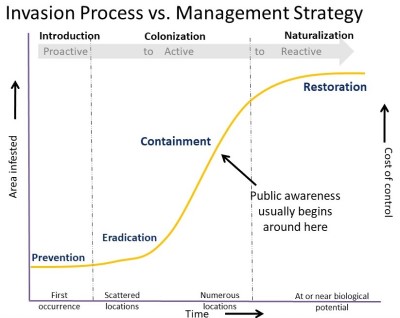Invasive Plants and Pandemics: Reflections from an Invasive Plant Ecologist
The coronavirus pandemic has given us all much to think about. As I navigate professional and personal responsibilities, I have been considering how my experience as an applied invasive plant ecologist can inform and guide my actions as a responsible citizen and vice versa. On a (solitary) trail run last weekend, I contemplated parallels between information and guidance provided to us from medical experts, public health specialists, and local, state, and national leaders and what we promote as professionals within the discipline of invasive plant management.

Graph line is S shaped with low initial abundance followed by exponential growth followed by leveling of abundance. Prevention and eradication should happen in the lower portion of invasive plant abundance.
One of the most obvious parallels is the importance of prevention, early detection and rapid response. “Flattening the curve” has been stated repeatedly by experts keeping us informed about the pandemic; the rationale behind this phrase is that by slowing the spread of the disease, medical providers will have more time and resources to treat those in need, and ultimately save more lives. Graphics used to display this concept remind me of those commonly used by educators and practitioners of invasive plant management when we preach the importance of detecting and eradicating a new invader early in order to prevent widespread establishment and associated negative ecological and economic impacts (see figure to left). Over the last several weeks, I have been encouraged by prime-time discussions of the value of proactive, preventative measures and widespread adoption of social distancing measures, signaling a general acceptance of the science behind them.
The value of prevention is difficult to measure, whether in the context of public health or invasive plant management. In the field of invasive species management, one statistic often shared is that $1 spent on prevention and early intervention saves $17 in later expenses, on average (OTA 1993 PDF). I calculated the economic benefit of a 20+ year cooperative project between land managers and county and state noxious weed management specialists to prevent and eradicate dyer’s woad, an invasive forb, from Montana; every dollar spent saved about $14 that would have been spent on large-scale chemical control of dyer’s woad had the species been allowed to spread. If we look back on our actions and feel we overreacted, we may have done exactly what we needed to do.
I, along with others I’ve spoken with recently, believe it is important to find something positive to take away from the current situation. My positive thought to share with you, as readers of the Monthly Weed Post, is this: I believe that we, as experts and proponents of invasive plant management, have a role to play in discussions and actions surrounding the coronavirus pandemic. In the present moment, we can help our family, friends, and neighbors understand the importance of prevention, early detection and rapid response and stand with them through inconvenient and challenging measures. Then, when the current situation passes, we can draw upon our shared experience to more fully engage our communities in proactive invasive plant management that prevents new and contains existing invasive plants in order to protect the lands we depend on for food, fiber, and inspiration.
Further Information
For more information on this month's Weed Post, contact Extension Invasive Plants specialist Jane Mangold. Past posts are available in the Monthly Weed Post directory.
The Printable PDF (300KB) version of this post includes a crossword puzzle.

